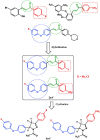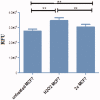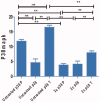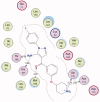Synthesis and biological evaluation of halogenated phenoxychalcones and their corresponding pyrazolines as cytotoxic agents in human breast cancer
- PMID: 34894967
- PMCID: PMC8667918
- DOI: 10.1080/14756366.2021.1998023
Synthesis and biological evaluation of halogenated phenoxychalcones and their corresponding pyrazolines as cytotoxic agents in human breast cancer
Abstract
Novel halogenated phenoxychalcones 2a-f and their corresponding N-acetylpyrazolines 3a-f were synthesised and evaluated for their anticancer activities against breast cancer cell line (MCF-7) and normal breast cell line (MCF-10a), compared with staurosporine. All compounds showed moderate to good cytotoxic activity when compared to control. Compound 2c was the most active, with IC50 = 1.52 µM and selectivity index = 15.24. Also, chalcone 2f showed significant cytotoxic activity with IC50 = 1.87 µM and selectivity index = 11.03. Compound 2c decreased both total mitogen activated protein kinase (p38α MAPK) and phosphorylated enzyme in MCF-7 cells, suggesting its ability to decrease cell proliferation and survival. It also showed the ability to induce ROS in MCF-7 treated cells. Compound 2c exhibited apoptotic behaviour in MCF-7 cells due to cell accumulation in G2/M phase and elevation in late apoptosis 57.78-fold more than control. Docking studies showed that compounds 2c and 2f interact with p38alpha MAPK active sites.
Keywords: Halogenated chalcones; ROS; breast cancer; cell cycle profile; diaryl ether; p38 MAPK; pyrazoline.
Conflict of interest statement
The authors declare that they have no conflicts of interest. The authors alone are responsible for the content and writing of this manuscript.
Figures













Similar articles
-
Novel Pyrazole-Chalcone Hybrids: Synthesis and Computational Insights Against Breast Cancer.Chem Biodivers. 2024 Jul;21(7):e202400015. doi: 10.1002/cbdv.202400015. Epub 2024 Jun 11. Chem Biodivers. 2024. PMID: 38705852
-
Synthesis, biological evaluation, and molecular modelling of new naphthalene-chalcone derivatives as potential anticancer agents on MCF-7 breast cancer cells by targeting tubulin colchicine binding site.J Enzyme Inhib Med Chem. 2020 Dec;35(1):139-144. doi: 10.1080/14756366.2019.1690479. J Enzyme Inhib Med Chem. 2020. PMID: 31724435 Free PMC article.
-
Biological Activity, Apoptotic Induction and Cell Cycle Arrest of New Hydrazonoyl Halides Derivatives.Anticancer Agents Med Chem. 2019;19(9):1141-1149. doi: 10.2174/1871520619666190306123658. Anticancer Agents Med Chem. 2019. PMID: 30843494
-
Novel benzothiazole-based dual VEGFR-2/EGFR inhibitors targeting breast and liver cancers: Synthesis, cytotoxic activity, QSAR and molecular docking studies.Bioorg Med Chem Lett. 2022 Feb 15;58:128529. doi: 10.1016/j.bmcl.2022.128529. Epub 2022 Jan 7. Bioorg Med Chem Lett. 2022. PMID: 35007724 Review.
-
2-Anilinopyrimidine derivatives: Design, synthesis, in vitro anti-proliferative activity, EGFR and ARO inhibitory activity, cell cycle analysis and molecular docking study.Bioorg Chem. 2020 Jun;99:103798. doi: 10.1016/j.bioorg.2020.103798. Epub 2020 Mar 29. Bioorg Chem. 2020. PMID: 32247112 Review.
Cited by
-
Novel 2-(5-Aryl-4,5-Dihydropyrazol-1-yl)thiazol-4-One as EGFR Inhibitors: Synthesis, Biological Assessment and Molecular Docking Insights.Drug Des Devel Ther. 2022 May 16;16:1457-1471. doi: 10.2147/DDDT.S356988. eCollection 2022. Drug Des Devel Ther. 2022. PMID: 35607598 Free PMC article.
-
Development of Potent Type V MAPK Inhibitors: Design, Synthesis, and Biological Evaluation of Benzothiazole Derivatives Targeting p38α MAPK in Breast Cancer Cells.Arch Pharm (Weinheim). 2025 Apr;358(4):e2500011. doi: 10.1002/ardp.202500011. Arch Pharm (Weinheim). 2025. PMID: 40194955 Free PMC article.
-
Novel pyrazolo[3,4-d]pyrimidine derivatives: design, synthesis, anticancer evaluation, VEGFR-2 inhibition, and antiangiogenic activity.RSC Med Chem. 2023 Nov 7;14(12):2640-2657. doi: 10.1039/d3md00476g. eCollection 2023 Dec 13. RSC Med Chem. 2023. PMID: 38107182 Free PMC article.
-
Advances in targeting p38 MAPK for cancer therapy: insights from molecular pharmacology and medicinal chemistry.Mol Divers. 2025 Jul 21. doi: 10.1007/s11030-025-11291-7. Online ahead of print. Mol Divers. 2025. PMID: 40690115 Review.
-
Design and synthesis of novel quinazolinone-based derivatives as EGFR inhibitors with antitumor activity.J Enzyme Inhib Med Chem. 2022 Dec;37(1):2644-2659. doi: 10.1080/14756366.2022.2118735. J Enzyme Inhib Med Chem. 2022. PMID: 36146940 Free PMC article.
References
-
- Boström J, Brown DG, Young RJ, Keserü GM.. Expanding the medicinal chemistry synthetic toolbox. Nat Rev Drug Discov 2018;17:709–27. - PubMed
-
- Singh I, Rani R, Luxami V, Paul K.. Synthesis of 5-(4-(1H-phenanthro[9,10-d]imidazol-2-yl)benzylidene)thiazolidine-2,4-dione as promising DNA and serum albumin-binding agents and evaluation of antitumor activity. Eur J Med Chem 2019;166:267–80. - PubMed
-
- El-dash Y, Elzayat E, Abdou AM, Hassan RA.. Novel thienopyrimidine-aminothiazole hybrids: design, synthesis, antimicrobial screening, anticancer activity, effects on cell cycle profile, caspase-3 mediated apoptosis and VEGFR-2 inhibition. Bioorganic Chemistry 2021;114:105137. - PubMed
-
- Caruso E, Malacarne MC, Marras E, et al. . New BODIPYs for photodynamic therapy (PDT): synthesis and activity on human cancer cell lines. Bioorg Med Chem 2020;28:115737. - PubMed
MeSH terms
Substances
LinkOut - more resources
Full Text Sources
Other Literature Sources
Medical
